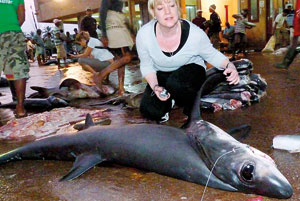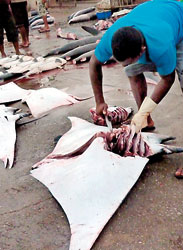 |
| Sonja looks at a big eye thresher shark |
“There is a creature alive today who has survived millions of years of evolution. Without change, without passion and without logic. It lives to kill. A mindless eating machine, it will attack and devour anything. It is as if God created the devil and gave him Jaws..!!” This scary introduction in Steven Spielberg’s 1975 blockbuster movie ‘Jaws’ painted a terrible picture of sharks as ruthless man-eaters.
Last week I got the opportunity to visit the Negombo shark landing site together with some shark experts. It was still dark when we reached there, but dozens of big multi-day fishing boats were already unloading their catch. After the tuna, it was time to unload the sharks. First came the smaller ones and then the bigger ones, some more than seven feet long from snout to tail. Their half open mouth showed their sharp teeth, but they didn’t fit the image of the ‘Savage killer of the sea’ – in fact the dead sharks lying on the decks reminded us of man’s supremacy even over the apex predator of the sea.
“We used to catch bigger sharks decades ago. Sometimes bigger than 10 feet,” says Anthony, a fisherman who proudly shows us the catch of his boat. Various species of sharks were being unloaded. Some fishermen target sharks, but many become the by-catch of the gill nets and long-line fisheries, where fishermen employ a long line with baited hooks. The sharks that are caught are stored in the freezers of the multi-day boats until they are brought to land.
Fins for a soup
However, it doesn’t end there. After being auctioned the sharks are sent to the processing area at the fish landing site for finning. Skilled fishermen with their sharp knives cut off the sharks’ dorsal fin, side and ventral fins and even the tail. The fins are then separately weighed and sold to the buyers engaged in the shark fin trade. The flesh is sent to the local market, but the fins are valued 10 times higher than the flesh, making it a lucrative business.
Manta Rays – the next target?

Manta Ray being processed for gilling |
Manta Rays, the largest Ray species (known in Sinhala as ‘Maduwa’) are being targeted for their gill rakers which are dried and used in Chinese traditional medicine for anything from diabetes to the common cold with no proven benefit. Mantas feed on plankton, fish larvae and the like and these gill rakers filter their food from the water passing through as they swim.
At the Negombo fish market, we saw a large Manta Ray being processed. According to the fishermen, it is also turning out to be a good business as one kg of gill rakers can be sold for Rs.10,000. Other than Manta Rays, Devil Rays too are been targeted for their gills. IUCN has categorized Manta Rays as threatened, so it is also the time to keep an eye on this species before it is too late. |
Hundreds of sharks face this fate every day. Many believe sharks are plentiful, but this is not the case. “The problem is sharks are slow breeders. Many of the species give birth after many months of pregnancy,” explained the president of Shark Advocates International Sonja Fordham who visited Negombo. Sonja is also the deputy head of the International Union of Conservation of Nature (IUCN)’s Shark Specialist Group.
One third of open ocean (pelagic) sharks are threatened with extinction. The IUCN Shark Specialist Group states that out of 64 species of open ocean (pelagic) sharks and rays, 32% are threatened with extinction, primarily due to over- fishing.
Shark fin soup which is a delicacy in East Asian countries has created a great demand for shark fins. This has turned out to be a lucrative business for the fishermen in many fishing nations. These fins are collected, dried and exported. The value of the fins depends upon the species. Sri Lanka ranks 14th in the world for shark and ray catch, based on the average landing data from 2000-2008,from the Food and Agriculture Organization (FAO). This data reveals that the average Sri Lankan shark and ray catch for the past years was 20,000 tonnes which makes 2.4% of the global catch.
About 15 Sri Lankan longline vessels target sharks and supply fins for export. More than 80, five-metre Sri Lankan hook fishing boats target deepwater gulper sharks, primarily for liver oil according to IUCN records. Offshore fisheries take mainly silky, blue, and oceanic whitetip sharks, with silky sharks making up 21% of the catch. These shark fins are mainly exported to Hong Kong, Malaysia, China, Singapore, Taiwan and Mauritius.
Shark fining
In Sri Lanka, there is no demand for shark flesh. This has led to another savage act – ‘Shark Finning’. Fishermen catch the sharks in the ocean, cut their fins and tails while the sharks are still alive and then dump them back into the sea. Shark-finning is savage as some of the footage uploaded on YouTube reveals.
Though banned in Sri Lanka, it is well known that local fishermen follow this practice. The regulations adopted in 2001 mandate that sharks be put back to sea with their fins still attached. This is by far the best method to end finning but only a few countries fishing in the Indian Ocean have adopted it, says Sonja.
Shark conservation
“At least the threatened species of sharks should be protected,” said Sonja showing us a few Big-eye Thresher Sharks and Hammerhead sharks at the Negombo landing site. Sonja pointed out that last year the Indian Ocean Tuna Commission (IOTC) had agreed to ban fishing of Thresher sharks and Sri Lanka too needs to adopt measures to ban fishing at least for these threatened species.
But how would fishermen distinguish shark species in the sea and leave out only the threatened ones?
“It would be harder to distinguish which species will be hooked by the net or long-line. But there are methods to unhook them safely and put them back to the sea,” Sonja said adding that this needs the co-operation of the fishermen. “However, when caught, sharks can be released, but some of the vulnerable shark species like Hammerheads are too delicate and will die quickly when entangled in a net or logline. Big-eye Thresher sharks have a higher chance of survival if released back to the waters,” Sonja said looking at the Thresher Shark which still had the entangled hook in its mouth, and the Hammerheads before us.
The Maldives took a bold step in shark conservation in March 2010 by banning shark fishing and declaring their waters as a sanctuary for sharks. They also banned the export of sharks and shark products in the country. Sri Lanka is also a Party to the Convention on Migratory Species (CMS), but is yet to sign the 2010 CMS Memorandum of Understanding on Migratory Sharks, pointed out Sonja.
Sustainable fishery the key
“Sustainability is the key,” said the head of National Aquatic Research Agency (NARA) and Secretary General of Indian Ocean Marine Affairs Cooperation (IOMAC) Dr. Hiran Jayewardene who last week launched Sri Lanka’s ‘Sustainable Fisheries Imitative’. Initially focusing on Sri Lankan fisheries, this initiative will eventually draw in other international players in the region as well as outside.
The Indian Ocean Tuna Commission (IOTC), resulting from an initiative by Sri Lanka in the 1980s, is concerned with sharks as a by-catch of tuna fishing. However, Sri Lanka together with India and Maldives has opposed a move proposed in the recently concluded Indian Ocean Tuna Commission (IOTC) to initiate a data collection programme for some specific shark species. Justifying the reasons for this opposition, Dr. Jayewardene – who is also the head of Sri Lankan Delegation to IOTC- said that
The Indian Ocean Tuna Commission (IOTC) has identified the Sri Lankan artisanal fishing fleet as a major fleet for which historical catch and information on sharks is needed. But we will need more time, he says as compliance with a multitude of international regulations is difficult when you have thousands of small boats making up your fleet. |



